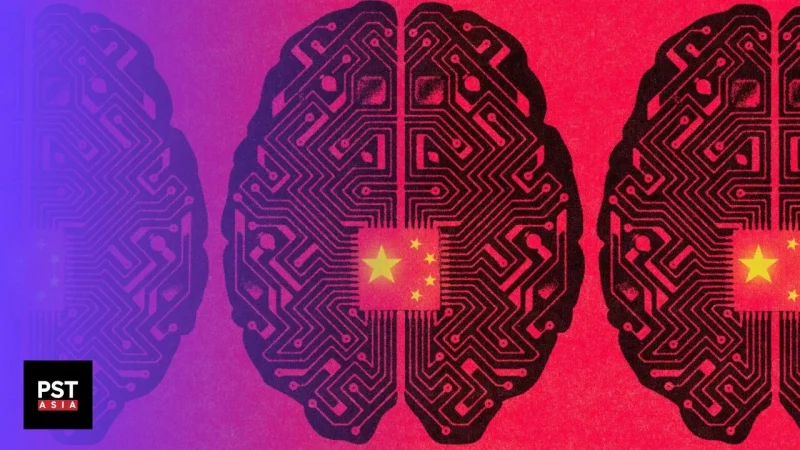One year ago, OpenAI publicly released ChatGPT, kick-starting a global AI race between companies looking to cash in on the newest tech.
And of course, Chinese companies quickly joined the race.
The country’s interest in AI goes back to 2021, when it was recognized by China’s leadership as one of seven frontier technologies that needed to be pursued in order to achieve technological self-reliance.
However, Beijing’s AI ambitions are facing growing headwinds as China’s biggest rival, the U.S., looks to restrict Chinese companies’ access to American technologies, which would prohibit Chinese clients from using the power of advanced AI chips.
In the midst of an economic crisis caused by a weakened property sector, can China overcome U.S. sanctions and achieve its AI ambitions? And will AI be China’s way out of its economic crisis?
China’s Search For Growth Engines
For a long time, the world’s second largest economy has depended on its massive real estate sector, which accounted for 25%-30% of its GDP at its peak. However, the real estate sector stopped being reliable after leading developers, such as Evergrande and Country Garden, defaulted on their debts and launched the country into a property crisis that slowed down the Chinese economy.
As a result, China started looking for alternative growth engines for the economy and made a list of seven frontier technologies that would become lifelines for the country’s economy. And so, it turned to AI. In addition to AI, quantum information science and semiconductors were high on the list.
So, for Chinese companies that believe advancing artificial intelligence is the future, making heavy and expensive investments is a certain thing over the next decade.
In fact, China is currently on course to spend $15 billion on AI projects this year alone, a rise of nearly 50% since 2021.
This heavy spending on AI will likely reach trillions of dollars, making AI a strategic driver of economic growth in China.
Companies in China have been growing effectively in an environment based on data, leading many to believe that AI and digitisation will be an area where Chinese companies can excel.
Even though China was aware of the importance of the AI sector in 2021, the surge in popularity of ChatGPT has also kick-started a new AI race involving generative AI.
China’s AI Ambitions
According to Violet Chung, senior partner at McKinsey & Company in China, generative AI could contribute economic benefits worth $2 trillion in China on an annual basis.
McKinsey & Company also stated that the impact of generative AI in China is mainly evident in the areas of research and development, software engineering, information technology, customer operations, marketing and sales.
By 2030, more than 50% of the jobs in China will be automated, and the automation rate will rise to 90% by 2050. So, as AI sets to replace human workers, it could have strong implications on China’s labor market.
AI could add more to the problem of the rising unemployment rate of people aged from 16 to 24 in China, which increased from 15.3% to 21.3% from 2022 to 2023.
This demographic was especially stressful to Chinese families that were affected by the one child policy, causing parents and their children to worry about future financial security.
Instead of addressing the issue, China decided to stop publishing unemployment figures and is now doing an AI push.
Challenges To China’s AI Sector
As big as China’s ambitions for the AI sector are, they will likely be extremely hard to achieve.
One of the problems facing China in that regard is its relations with the U.S..
The U.S. government started a trade war with China in 2018 in order to curb Chinese companies’ access to American technologies, such as cloud-computing services and new chip technologies.
The U.S. wanted to stop state-owned Chinese companies from extorting patents and rights to intellectual property from American tech companies operating in China, so it started imposing extensive tariffs on commodities traded with China.
These sanctions on China have put a delay on its AI ambitions, since advanced AI systems require massive amounts of hardware including very specialized chips, which China can’t currently get its hands on.
A good example of how extremely the sanctions impacted China is the amount of foreign investment in the country’s semiconductor sector, which decreased from 48% in 2018 to 1% in 2022. In contrast, the U.S. share increased from zero to 37%.
As chip technology continues to advance, the gap in the AI sector between China and the West is likely to keep widening.
Chinese tech firms and American companies that don’t want to lose out on the Chinese markets have tried to find other ways around the ban. An example for this is the market leading AI computing firm Nvidia, which touted to Chinese customers a new AI chip designed specifically to comply with the latest U.S. export rules.
But Nvidia couldn’t launch the new AI chips in time, and delayed them until the first quarter of next year. The reason for the delay is unclear, but it seems like several manufacturers were having trouble integrating the new chips.
As a result of the delay, Nvidia’s share price dropped by around 4%, though it has recovered slightly now.
Since Nvidia’s share in the AI chip market is around 80%, you might think that a delay of a few months shouldn’t be a big deal for a company that dominates the market like that, but China contributes a lot to Nvidia’s revenues.
In fact, China accounts for 20% to 25% of Nvidia’s revenue in its data center business, the company’s biggest unit. So, it’s easy to see why Nvidia wants to retain China as a customer, especially since local competition increased from firms such as Huawei, which has sold a notable number of AI chips to Chinese internet giant Baidu.
The rising tensions between China and the U.S. has caused Chinese companies, such as the emerging AI startup 01.AI, to buy Nvidia products in bulk earlier this year, before the U.S. government imposed tighter restrictions on China.
The startup bought enough of the chips to last for the next 18 months or so, according to its founder and CEO Kai-Fu Lee. He also added that Nvidia’s GPUs are considered the most advanced for training AI models, like OpenAI’s GPT4.
So, Chinese AI companies are finding their ways around the U.S. sanctions, but can they do the same with the CCP’s regulations?
Despite AI’s strategic importance to drive up the slowing economy, its rapid development has also raised concerns, with state media saying the risks associated with the advancements of AI involve intellectual property rights, privacy and fraud.
In June of this year, China was one of the earliest countries in the world to issue regulations on generative AI models, seeking to control the rise of ChatGPT and services similar to it.
Chinese companies responded to the new regulations by creating their own regulations in an attempt to get ahead of any possible alleged violations. For example, a chatbot platform called Glow, which specializes in creating character-driven “intelligent agents”, released new rules on the amount of time users can spend on the platform.
These new rulers were likely motivated by an article in the regulations, which says that service providers should use “appropriate measures to prevent users from excessive reliance on generated content.”
Additionally, the company added “anti-addiction measures” that cap daily usage of the app to three hours. If users go over the time limit, any messages they hope to send to chatbots will be blocked. In a way, the Chinese government operates similarly to a helicopter parent.
To put it simply, we simply can’t expect the government that successfully implemented the Great Firewall and investigated and raided many of the world’s leading tech companies to allow generative AI to prosper.
The country’s tough regulatory environment is also helped by the compliance from its tech companies, and is used by the Chinese government to preserve the current status quo, even if it leads to pushing foreign investors away.
What’s Next?
Despite the U.S. sanctions and the country’s own tough regulations, China thinks that it can become a global AI leader in the next decade, setting many timelines for development.
But it still has a long way to go, especially since it seems like pursuing the goals of technological advancement and tight information control go hand in hand for China and can’t be separated.
This of course places hurdles in China’s path to dominate the AI sector. As disappointing as it is for Chinese and foreign tech businesses alike, the Chinese government seems to prioritize ideology over achieving the next big AI leap, that would possibly save China from an economic crisis.
Perhaps the biggest uncertainty is whether the CCP will allow the private companies currently leading the charge in AI to thrive. While officials are trying to reassure foreign investors that the environment for foreign businesses will improve, nothing happened that suggests Beijing will loosen its tight grip over the AI sector.
Disclaimer
Please visit and read our disclaimer here.









